Galleries
David Ebony’s Top 10 New York Gallery Shows for May
Tiffany Chung, Al Held, and Lisa Yuskavage are on the itinerary.
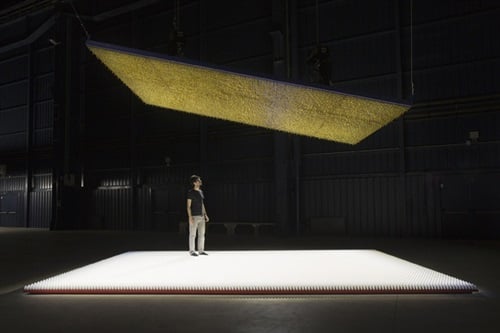
Tiffany Chung, Al Held, and Lisa Yuskavage are on the itinerary.

David Ebony

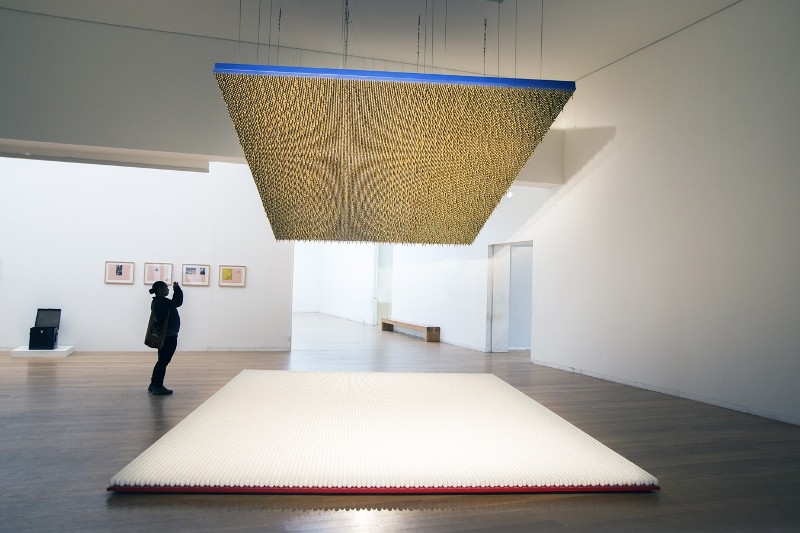
Cildo Meireles, Amerikkka, 1991/2013,
Photo: Courtesy of Galerie Lelong.
1. Cildo Meireles at Galerie Lelong, through June 27.
This marks the first U.S. solo show in a decade for Brazilian conceptualist maestro Cildo Meireles. On view are a number of recent sculptures and installations, shown here for the first time, plus re-workings of several classic Meireles pieces, which lend the show the feel of a mini-retrospective.
The Rio de Janeiro-based artist uses a specialized metaphorical visual language to tackle a broad range of social and political issues in his work. In Aquarium (2015), for instance, he comments on the fact that while Brazil contains approximately 12 percent of the world’s fresh water, there is a dire water shortage in the country’s largest city, São Paolo. This sculpture consists of two glass vessels on a white-painted wood shelf. One container is filled with water, and the other with gold, an allusion to the vast amount of water used in the country’s mining industries.
The tour de force here is Amerikkka (1991/2013), a large-scale interactive installation featuring two expansive rectangular panels, one suspended over the floor at a slight angle, and covered with 40,000 golden bullets of various sizes. The lower panel is a platform covered with white-painted wooden eggs which allude to the apocryphal story whereby Christopher Columbus, in an effort to explain his global adventure, balanced an egg at the edge of a table by flattening its tip.
In a rather subversive gesture, Meireles invites visitors to walk on the platform without shoes. Moving around the unforgiving, lumpy surface is hard on the feet, but the effort is highly recommended. It intensifies the experience of looking up at the threatening canopy of bullets just overhead.

Installation view. Mary Corse, 2015.
Photo: Courtesy Lehmann Maupin.
2. Mary Corse at Lehmann Maupin, through June 13.
As one of the few women associated with the ultra-macho Light & Space movement in Southern California in the 1960s, Mary Corse has honed a refined form of expression that sets her work apart. At first, her endeavor appears to be a rarified type of minimalist painting, most often using a reductive palette of white and grays, and spare compositions of vertical bands. She uses acrylic paint mixed with microspheres—tiny reflective glass beads often used for the white line dividers of highways. The light from the reflective surfaces intensifies as one moves around these elegant canvases.
This riveting show of recent works is extraordinary in its use of color. The first gallery features compositions with bands of blue and white, while others highlight works with red, yellow and black. These are commanding pieces by a veteran artist in top form.
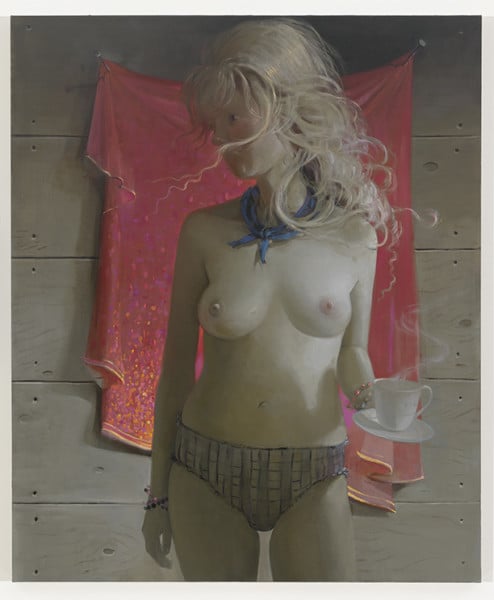
Lisa Yuskavage, Sari, 2015.
Photo: Courtesy David Zwirner Gallery.
3. Lisa Yuskavage at David Zwirner, through June 13.
In her best exhibition in years, Lisa Yuskavage continues to employ the refined painting technique and the exaggerated sexploitation imagery with which she established her career. In these new and ambitious paintings, Yuskavage claims a unique approach to narrative that is more complex and thought-provoking than before. There are the familiar, big-breasted female nudes, and also a quirky cast of well-endowed male nudes in the mix.
In evidence here is a fresh, nuanced vision that seems poignant and vital. In works like Sari (2015), Yuskavage offers a rather graceful study of a topless young woman holding a steaming cup of tea. There is an idyllic serenity to the image. By contrast, The Neighbors (2014) conveys a scandalous tale of suburban intrigue by featuring a nude male and female couple ostensibly having had a tryst alongside a tall, white picket fence. Paintings such as Hippies (2013) and Mardi Gras Honeymoon (2015) suggest that each of Yuskavage’s hedonistic flesh-pot fantasies encompasses a cautionary tale. Beyond the moral issues, the work proposes an even greater psychological as well as practical dilemma. Once the orgy is over, and the giddy high has subsided, is there any place that might be called “home”?
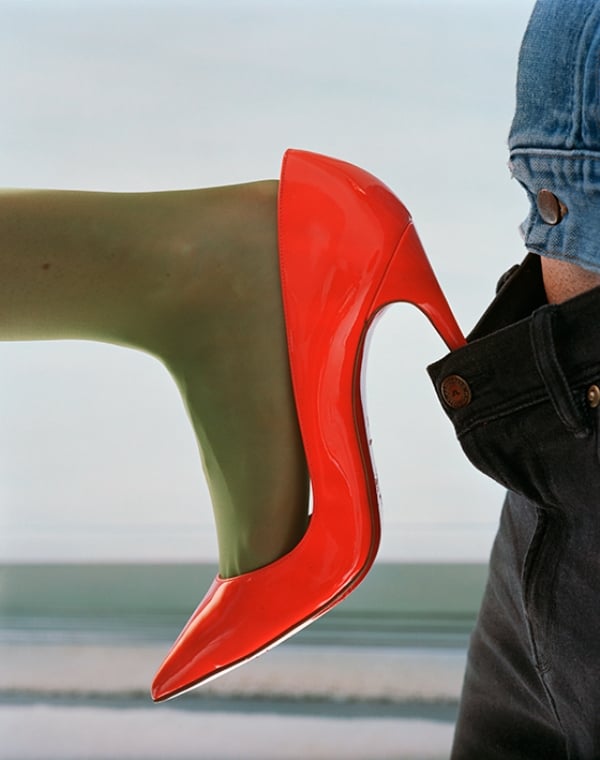
Torbjørn Rødland, Red Pump, (2015). Photo: Courtesy Algus Greenspon.
4. Torbjørn Rødland at Algus Greenspon, through June 20.
The orgiastic images by Norwegian-born, Los Angeles-based photo artist Torbjørn Rødland convey a very specific and eccentric world view. His range is broad, including figure studies, still lifes and slice-of-life craziness that sometimes seems cacophonous and disjointed. This excellent show of 10 recent works, titled, “Corpus Dubium,” shows there can be cohesiveness to his vision.
The exhibition’s title in Latin means “Body Doubt” or Dubious Body,” and it kicks off with Drunken Man (2015), a large photo showing an overweight, shirtless bloke drenched in red wine. This modern day Bacchus sets the tone for the nine other works on view. The Mirror (2015) features a back-lit nude woman taking a selfie. Some of the images, such as Red Pump (2015), showing a red high heel lodged in the waistband of a man’s pants, have the slickness of fashion shoots. But the quirky eroticism of this piece, and others in the show, is rather far removed from conventional commercial photography.
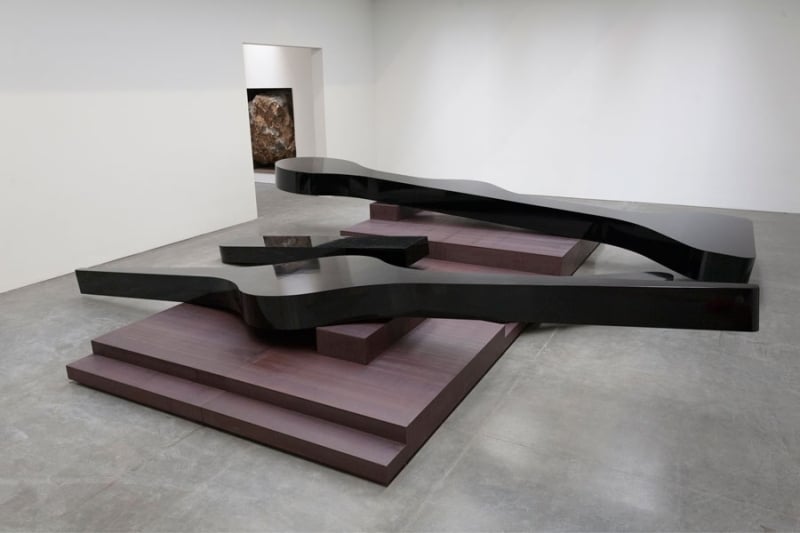
Installation view. Michael Heizer “Altars,” 2015.
Photo: Courtesy Gagosian Gallery.
5. Michael Heizer at Gagosian Gallery, through July 2.
This exhibition of monumental works by Michael Heizer makes a strong case for the legendary status of this reclusive artist, who lives and works in the Nevada desert. For decades, he has been preoccupied with creating The City, a vast earth work covering over a mile-long stretch of land with berms and architectonic structures that resemble the ruins of some long-lost civilization. Few people have ever seen this piece in person, due to its remote location. So it’s a rare opportunity to experience Heizer’s art by means of this exceptional New York gallery show—his first at Gagosian.
“Michael Heizer: Altars” is an awesome spectacle featuring a number of massive “hanging boulder” sculptures, such as Asteroid (c. 2000), a 12-ton cinnamon-hued ore rock ensconced in a specially designed wall alcove, and the even mightier, 18-ton hunk of granite, titled, Potato Chip (2015). Carefully arranged on tiered steel platforms throughout the gallery spaces are the “Altars,” shaped metal objects, up to 40 by 40 feet, that were inspired by the forms of pictographs, like those of ancient desert rock carvings. A special treat in the show is a room filled with several large, shaped canvases, early paintings, from the 1960s, with spare compositions that demonstrate Heizer’s minimalist roots, and hint at his later architectural inclinations and ambitions.
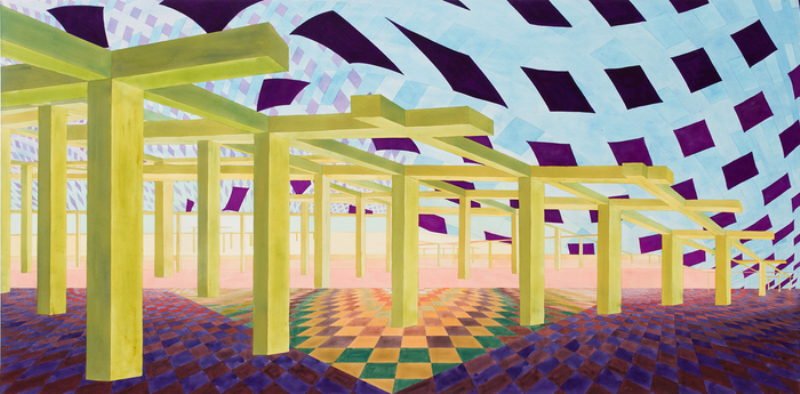
Al Held, Particular Paradise 5 (1999).
Photo: Courtesy Van Doren Waxter.
6. Al Held at Van Doren Waxter, through July 2.
Al Held’s complex architectural vision has the look of computer graphics and sci-fi imagery, which play out in his richly colored abstract paintings. Yet, the Brooklyn-born artist, who died in Camerata, Italy, in 2005, at age 76, never employed computer programs for his work. Instead, his intricate and refined compositions are largely based on spaces found in Renaissance art, with which he surrounded himself in the environs of Umbria, Italy, where he lived and worked since the 1980s.
“Al Held: Particular Paradox” highlights a rare late series of large watercolors painted in Italy from 1999 and 2000. The works appear as paintings on canvas, since Held mounted the pliable, handmade paper over the sides of wood panels, like stretcher frames. The painted sides of each piece are integral to the overall composition.
Some of the works on view can be counted among Held’s best efforts. Particular Paradox 5 (1999) seems to describe the interior of a futuristic structure, with a network of beams situated beneath a domed ceiling of blue and purple rectangles. Particular Paradox 30 (2000) is a fine example of Held’s incorporation of the fourth dimension in his work. Here, various configurations of geometric forms seem to hover in space; contradictory perspectives and spatial relationships require the element of time to absorb the entire image, which needs to be scanned rather than viewed straight on.
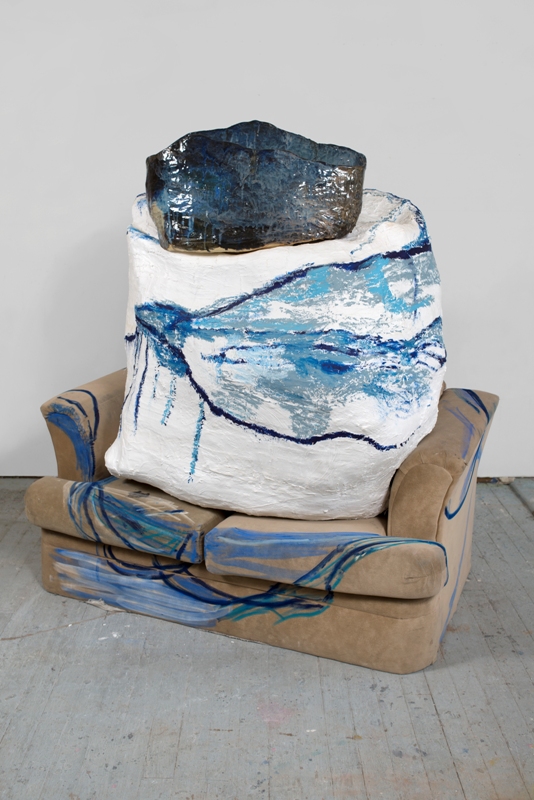
Jessica Jackson Hutchins, Ultrasuede Wave (2015).
Photo: Courtesy Marianne Boesky Gallery.
7. Jessica Jackson Hutchins, at Marianne Boesky Gallery, through June 13.
In this show of recent works, titled, “Jessica Jackson Hutchins: I Do Choose,” the Chicago-born artist creates a haunting tableau of sculptures and reliefs that seems to reference domestic interiors. Reconstituted or sometimes imploded elements—overstuffed chairs piled up with funky ceramic vessels, found furniture slathered with paint, and battered found objects and mutilated canvases—might seem to constitute a nightmarish vision. But Hutchins’s work may be considered more as an apocalyptic reverie, full of tongue-in-cheek humor.
Wall-hung pieces like Third Eye, featuring a broken folding chair attached to an anarchically painted abstract canvas, is certainly striking, but maybe owes too great a debt to Robert Rauschenberg’s “Combines.” Hutchins is at her best in pieces like Ultrasuede Wave (2015), in which a large glazed ceramic object sits atop a beige sofa painted here and there with rough markings in blue and white, hinting at the aquatic theme referenced in the title. In some way, this memorable work suggests a couch potato’s daydream of an afternoon at the beach.
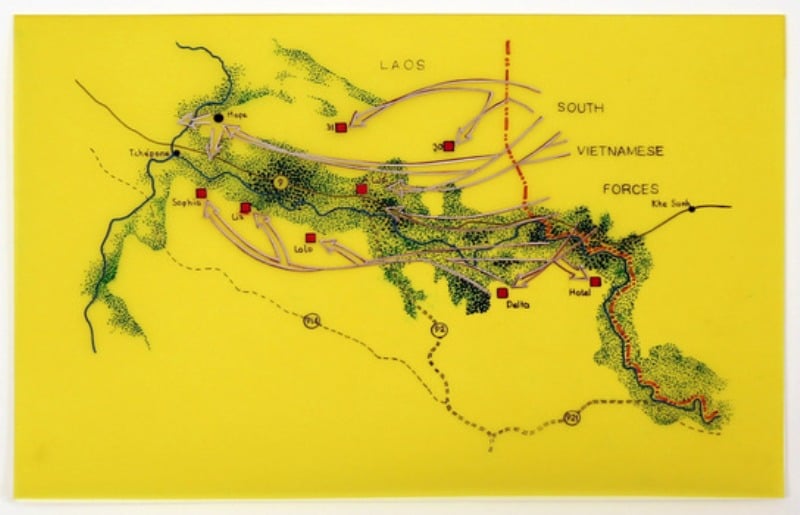
Tiffany Chung, Operation Lam So’n 719 in 1971 (2015).
Photo: Courtesy Tyler Rollins Fine Art.
8. Tiffany Chung at Tyler Rollins Fine Art, through June 26.
The beauty of Tiffany Chung’s exhibition is in the details. “Finding one’s shadow in ruins and rubble” contains dozens of small works, more in the order of archival fragments, interconnecting three major themes centered on the long-term effects of natural and man-made disasters: the devastating 1995 earthquake in Kobe, Japan; the battlefields of the Vietnam War; and the ongoing war in Syria. The Vietnam War-related works have special significance for the artist, whose father was a pilot for the South Vietnamese Air Force during the war.
Chung’s interests in cartography are evident in each of the meticulous, map-like drawings designating locations of specific historical events and their aftermath, including disused and ruined airstrips throughout South Vietnam, and sites of devastation in and around Kobe, Japan, where the artist worked for some years. The series focused on Syria features a group of light boxes placed on the floor, which contain images of the ruins of Homs, a once-vital urban center.
Coinciding with this show, Chung presents a new series of works in the current Venice Biennale, as part of curator Okwui Enwezor’s exhibition “All the World’s Futures,” on view through November 22.
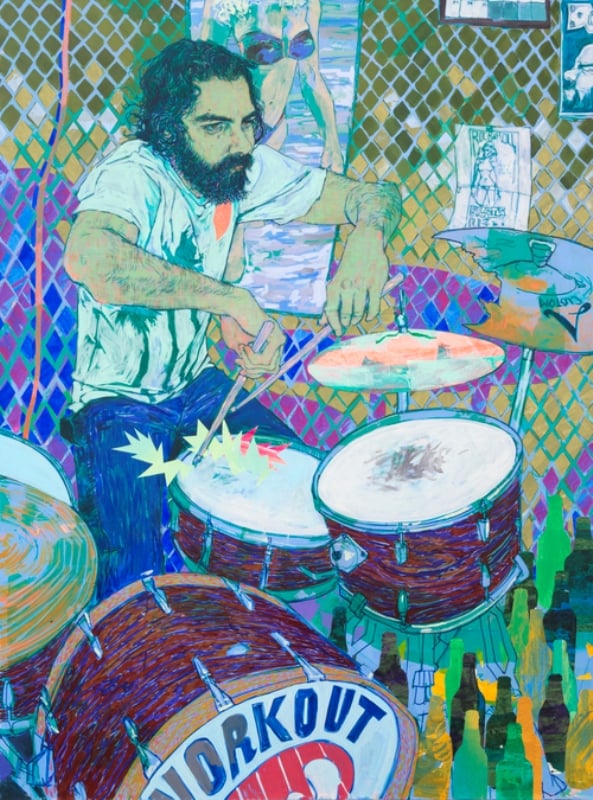
Hope Gangloff, Dark Horse (Tim Traynor), 2015. Photo: Courtesy Susan Inglett Gallery.
9. Hope Gangloff at Susan Inglett, through June 6.
In the midst of the overwhelming preponderance these days of photo-based paintings, New York artist Hope Gangloff has the audacity to paint from life. Employing a colorful, highly stylized brand of image-making, with influences ranging from Egon Schiele to Alice Neel and Sylvia Sleigh, Gangloff manages to capture in her large-scale portraiture some convincing and lively personalities.
Among the highlights of this show of recent works is Yelena, featuring a standing figure in a colorful dress and boots, set against at searing background of interlocking Matissean patterns. And Dark Horse (Tim Traynor)(2015), a similarly compelling image, shows the bearded drummer for the Brooklyn-based band Workout as he pounds away at his kit.
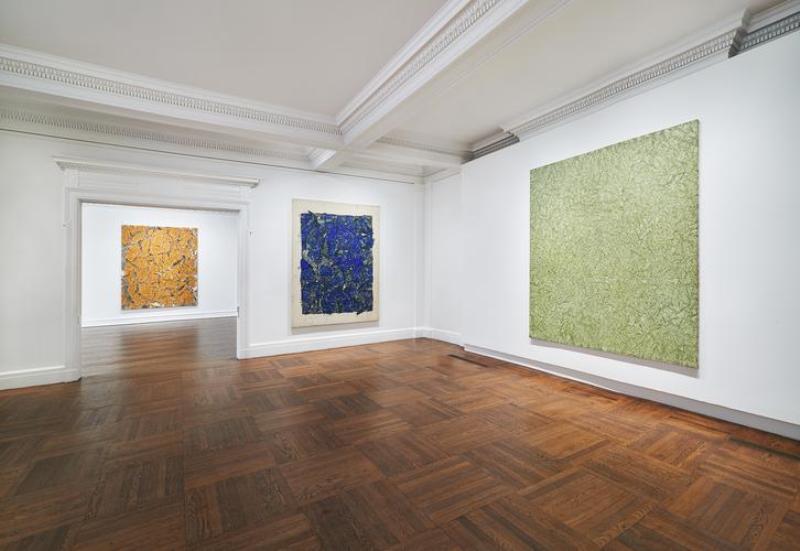
Installation view. Simon Hantaï, 2015.
Photo: Courtesy Mnuchin Gallery.
10. Simon Hantaï at Mnuchin Gallery, through June 26.
“Pliage: The First Decade,” is a stunning show of large-scale abstract paintings of the 1960s by the late Hungarian-born French artist Simon Hantaï. The artist had a major influence on the Support/Surfaces group of the French avant-garde. Inspired by Jackson Pollock, Hantaï had an early ambition to reinvent painting. He developed a number of novel techniques, many of which are evident in the resplendent works currently on view.
Hantaï experimented with “pliage” or a folding method, in which he knotted and crumbled the unstretched canvases on the floor before painting. Afterward, the unfurled and stretched canvas revealed elaborate and chance patterns of fragmented shapes in vivid colors, suggesting light and movement.
Among the five series of works represented in this show, “Panses” are centralized compositions with richly textured surfaces. Some of them, such as M.M. 2 (1964), recall multifaceted gems. In the more familiar monochrome “Études,” white forms of unpainted negative space recall leaf shapes. Most striking of all are works from the “Mariales” series, including Mariale M.C. 7 (1962), in which the dense and intense textures resemble those of geological formations or the surface crazing of glazed ceramics.
David Ebony is contributing editor of Art in America and a longtime contributor to artnet.